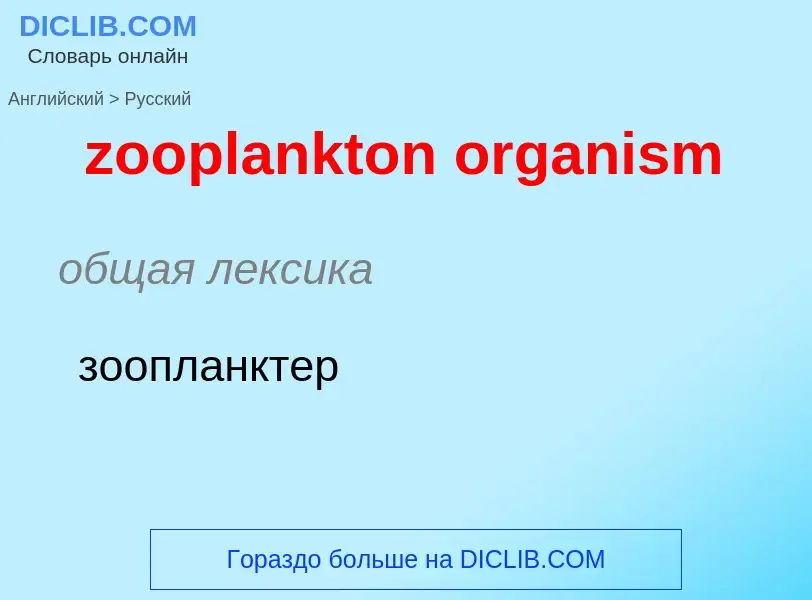Перевод и анализ слов искусственным интеллектом
На этой странице Вы можете получить подробный анализ слова или словосочетания, произведенный с помощью лучшей на сегодняшний день технологии искусственного интеллекта:
- как употребляется слово
- частота употребления
- используется оно чаще в устной или письменной речи
- варианты перевода слова
- примеры употребления (несколько фраз с переводом)
- этимология
zooplankton organism - перевод на русский
общая лексика
зоопланктер
['ɔ:gəniz(ə)m]
общая лексика
организм
микроорганизм
микрофлора
Смотрите также
существительное
общая лексика
организм
живое существо
организация
орган
биология
микроорганизм
медицина
живой организм
Определение
Википедия

The biological pump (or ocean carbon biological pump or marine biological carbon pump) is the ocean's biologically driven sequestration of carbon from the atmosphere and land runoff to the ocean interior and seafloor sediments. In other words, it is a biologically mediated process which results in the sequestering of carbon in the deep ocean away from the atmosphere and the land. The biological pump is the biological component of the "marine carbon pump" which contains both a physical and biological component. It is the part of the broader oceanic carbon cycle responsible for the cycling of organic matter formed mainly by phytoplankton during photosynthesis (soft-tissue pump), as well as the cycling of calcium carbonate (CaCO3) formed into shells by certain organisms such as plankton and mollusks (carbonate pump).
Budget calculations of the biological carbon pump are based on the ratio between sedimentation (carbon export to the ocean floor) and remineralization (release of carbon to the atmosphere).
The biological pump is not so much the result of a single process, but rather the sum of a number of processes each of which can influence biological pumping. Overall, the pump transfers about 10.2 gigatonnes of carbon every year into the ocean's interior and a total of 1300 gigatonnes carbon over an average 127 years. This takes carbon out of contact with the atmosphere for several thousand years or longer. An ocean without a biological pump would result in atmospheric carbon dioxide levels about 400 ppm higher than the present day.





![50px]] Modified text was copied from this source, which is available under a [https://creativecommons.org/licenses/by/4.0/ Creative Commons Attribution 4.0 International License].</ref> 50px]] Modified text was copied from this source, which is available under a [https://creativecommons.org/licenses/by/4.0/ Creative Commons Attribution 4.0 International License].</ref>](https://commons.wikimedia.org/wiki/Special:FilePath/Components of the biological pump 2018.jpg?width=200)
![The nitrogen fixing cyanobacteria ''[[Cyanothece]]'' sp. ATCC 51142 The nitrogen fixing cyanobacteria ''[[Cyanothece]]'' sp. ATCC 51142](https://commons.wikimedia.org/wiki/Special:FilePath/Cyanothece sp. ATCC 51142 cell.jpg?width=200)

![50px]] Modified text was copied from this source, which is available under a [https://creativecommons.org/licenses/by/4.0/ Creative Commons Attribution 4.0 International License].</ref> 50px]] Modified text was copied from this source, which is available under a [https://creativecommons.org/licenses/by/4.0/ Creative Commons Attribution 4.0 International License].</ref>](https://commons.wikimedia.org/wiki/Special:FilePath/Gelatinous zooplankton biological pump.png?width=200)


![50px]] Modified text was copied from this source, which is available under a [https://creativecommons.org/licenses/by/4.0/ Creative Commons Attribution 4.0 International License].</ref> 50px]] Modified text was copied from this source, which is available under a [https://creativecommons.org/licenses/by/4.0/ Creative Commons Attribution 4.0 International License].</ref>](https://commons.wikimedia.org/wiki/Special:FilePath/Marine connections between the living and the nonliving.png?width=200)
![The microbial loop is a marine trophic pathway which incorporates [[dissolved organic carbon]] (DOC) into the food chain The microbial loop is a marine trophic pathway which incorporates [[dissolved organic carbon]] (DOC) into the food chain](https://commons.wikimedia.org/wiki/Special:FilePath/Microbial Loop.jpg?width=200)
![doi-access=free }}</ref> and the other from the NASA EXPORTS plan.<ref>[[Committee on Earth Observation Satellites]] (2014) "CEOS strategy for carbon observations from space". Response to the [[Group on Earth Observations]] (GEO) carbon strategy. Printed in Japan by JAXA and I&A Corporation.</ref></small>}} doi-access=free }}</ref> and the other from the NASA EXPORTS plan.<ref>[[Committee on Earth Observation Satellites]] (2014) "CEOS strategy for carbon observations from space". Response to the [[Group on Earth Observations]] (GEO) carbon strategy. Printed in Japan by JAXA and I&A Corporation.</ref></small>}}](https://commons.wikimedia.org/wiki/Special:FilePath/Monitoring the ocean biological carbon pump.jpg?width=200)
!['''Morphology of zooplankton fecal pellets{{hsp}}<ref name=Belcher2017 />'''<br />Collected from [[marine snow]] catchers (a–c) and [[sediment trap]]s (d–f).<br />Morphological classes: (a, d) round, (b, e) cylindrical, and (c, f) ovoid.<br /><small>Scale bar {{=}} 0.5 mm</small>}} '''Morphology of zooplankton fecal pellets{{hsp}}<ref name=Belcher2017 />'''<br />Collected from [[marine snow]] catchers (a–c) and [[sediment trap]]s (d–f).<br />Morphological classes: (a, d) round, (b, e) cylindrical, and (c, f) ovoid.<br /><small>Scale bar {{=}} 0.5 mm</small>}}](https://commons.wikimedia.org/wiki/Special:FilePath/Morphology of copepod faecal pellets.png?width=200)



![sedimentation]] (carbon export) and [[remineralization]] (release to the atmosphere).<ref name=Ionescu2015 /> sedimentation]] (carbon export) and [[remineralization]] (release to the atmosphere).<ref name=Ionescu2015 />](https://commons.wikimedia.org/wiki/Special:FilePath/Phytoplankton and the biological carbon pump.webp?width=200)



![Global estimate of the vertically integrated anthropogenic [[dissolved inorganic carbon]] (DIC) in the ocean in recent times (1990s) Global estimate of the vertically integrated anthropogenic [[dissolved inorganic carbon]] (DIC) in the ocean in recent times (1990s)](https://commons.wikimedia.org/wiki/Special:FilePath/WOA05 GLODAP invt aco2 AYool.png?width=200)
![The [[whale pump]] is the role played by whales and other marine mammals recycling nutrients in the ocean The [[whale pump]] is the role played by whales and other marine mammals recycling nutrients in the ocean](https://commons.wikimedia.org/wiki/Special:FilePath/WhalePump.jpg?width=200)
![( see below ↓ )]]}} ( see below ↓ )]]}}](https://commons.wikimedia.org/wiki/Special:FilePath/White cliffs of dover 09 2004.jpg?width=200)

![Size contrast of small cylindrical [[bacterial]] cells to large single-celled eukaryotic ''[[Paramecium]]''. Size contrast of small cylindrical [[bacterial]] cells to large single-celled eukaryotic ''[[Paramecium]]''.](https://commons.wikimedia.org/wiki/Special:FilePath/Gram-negative Bacteria and Paramecium forming cyst.jpg?width=200)
![Wood–Ljungdahl or reductive acetyl–CoA pathway]] to fix carbon. Wood–Ljungdahl or reductive acetyl–CoA pathway]] to fix carbon.](https://commons.wikimedia.org/wiki/Special:FilePath/Reduktiver Acetyl-CoA-Weg.png?width=200)
![Gya]] (billion years old) [[geological formation]]s contain fossilized [[cyanobacteria]] microbes. This suggests they are evidence of one of the earliest known life forms on Earth. Gya]] (billion years old) [[geological formation]]s contain fossilized [[cyanobacteria]] microbes. This suggests they are evidence of one of the earliest known life forms on Earth.](https://commons.wikimedia.org/wiki/Special:FilePath/Stromatolites.jpg?width=200)
